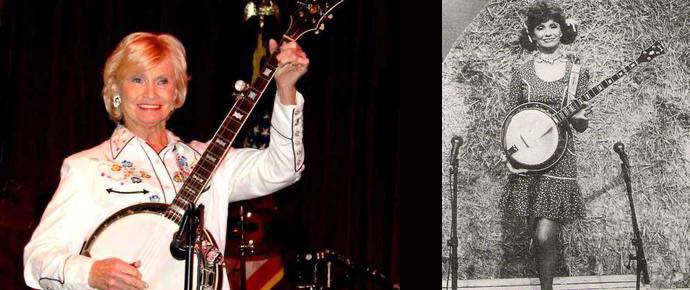
Roni Stoneman, banjo player with The Stonemans, who played the iconic Hee-Haw character, Ida Lee Nagger, died yesterday evening at 85 years of age.
Long before she played that comic stereotype on television in the 1970s, Roni was an established artist in bluegrass music performing with her family, The Stonemans, in the late 1950s and ’60s. There she played Scruggs style banjo, and took on a comedic role on stage, quite a typical part of most country, hillbilly, or bluegrass acts of that day.
Born Veronica Loretta Stoneman on May 5, 1938, she was the youngest of Ernest and Hattie Stoneman’s 23 children. Ernest, known as “Pop,” was one of the very first country music stars in the US when his recording of Sinking of the Titanic became a massive hit in 1925, even before the heralded Bristol Sessions in 1927 that launched the record industry’s fascination with hillbilly music. He was deeply involved in those sessions as well, and played a role in getting Ralph Peer to make his storied and historic visit.
After great initial success, Pop and the Stoneman family lost everything in the Depression, and he didn’t resurface, with family in tow, until 1947. Roni and her sister, Donna, sang with help from brothers Jimmy on guitar and Scotty, most notably on fiddle, along with Pop in command. They performed under a number of different names, including Pop Stoneman and His Little Pebbles, who won the Old Fiddler’s Convention in Galax in 1956, until eventually settling on The Stonemans in 1962. Roni joined officially in 1957.
The Stonemans won a number of televised talent competitions, including the Arthur Godfrey Talent Search program, which was extremely popular among the limited offering at the time. They recorded for Starday and played the Grand Ole Opry with their slightly “corny” hillbilly bluegrass style, until a switch to the MGM label had them leaning more into country music.
The family moved from the Washington, DC capitol area to Nashville in 1966, but Pop died the following year, and Roni left the band. Her solo career flourished, but it was her coming on to Hee-Haw that made her a familiar face all over the US. Never a glamour girl, Roni adopted the role of an unattractive mountain maiden, with teeth blacked out and hair all awry for the sake of the show.
Throughout all, she continued to play her Gibson RB-250 Bow Tie model, right up to the end where she and Donna did shows together, just the two of them. She often played it on Hee-Haw in their banjo segments, alongside other noted players and personalities like Grandpa Jones, Roy Clark, Buck Trent, and Bobby Thompson.
Though she was a fine banjo player, it was Roni’s personality that ultimately won her so many fans. She would wander through the crowds at festivals, shaking hands and chatting with all comers. I’ll never forget when she came up to me at SPBGMA one year and said, “You look like a banjo player.” When I answered in the affirmative, she placed her right palm on my forehead and hollered, “Be healed!”
Unlucky in love, Roni had three unsuccessful marriages, two of her husbands being partners in her business. But she smiled through it all, entertaining people of every sort until quite recently when poor health required her to stop.
He autobiography, Pressing On, written with Ellen Wright, was released in 2007 by the University of Illinois Press. It details her determination to keep pushing forward as a solo artist and entertainer, starting at a time when women on their own were not always embraced by the industry.
In the end, she earned every bit of the right to call herself, “The First Lady of the Banjo,” a title bestowed on her by the music industry in Nashville.
Roni Stoneman was both a pioneer and a legend in bluegrass and country music.
R.I.P., Roni Stoneman.







